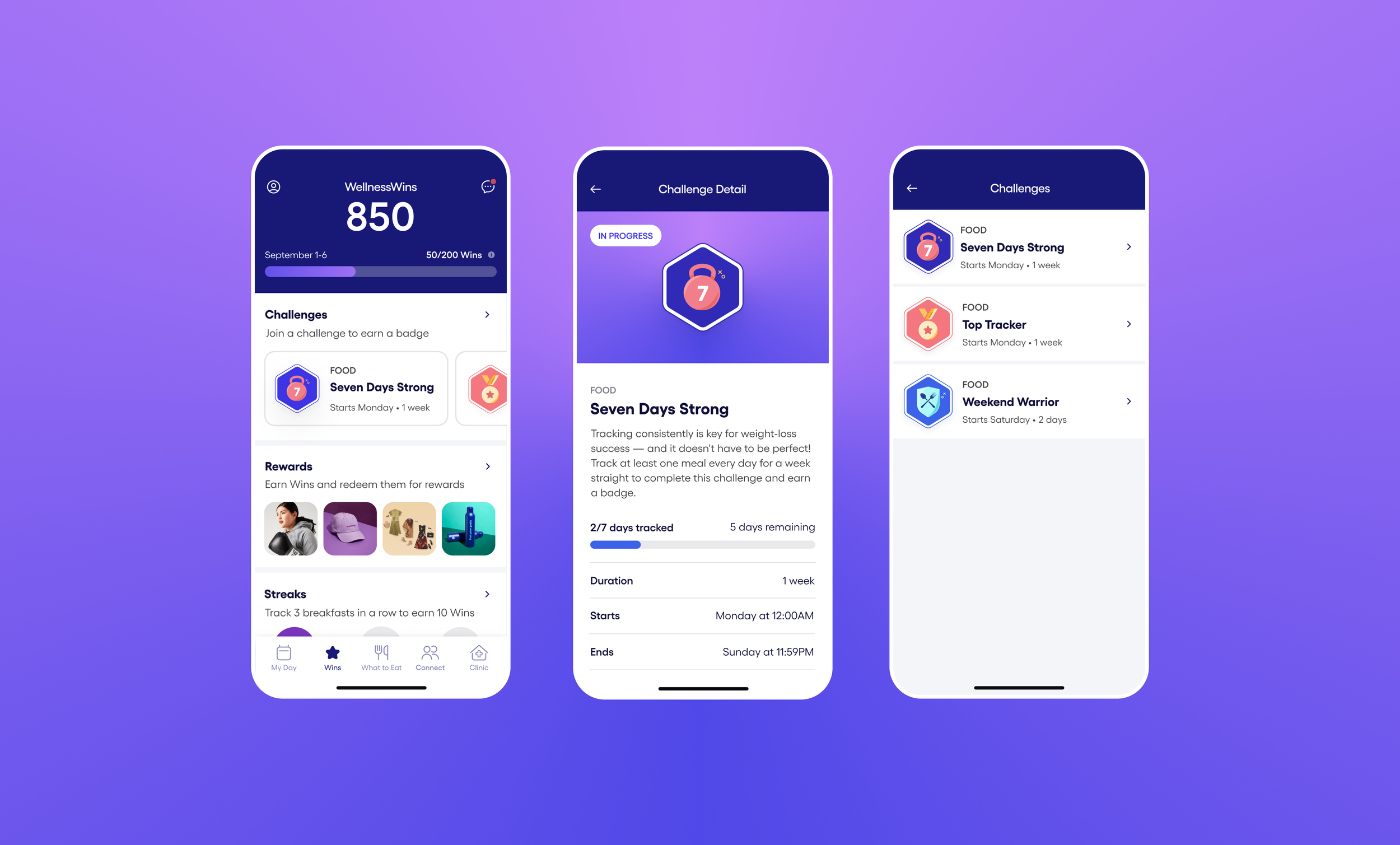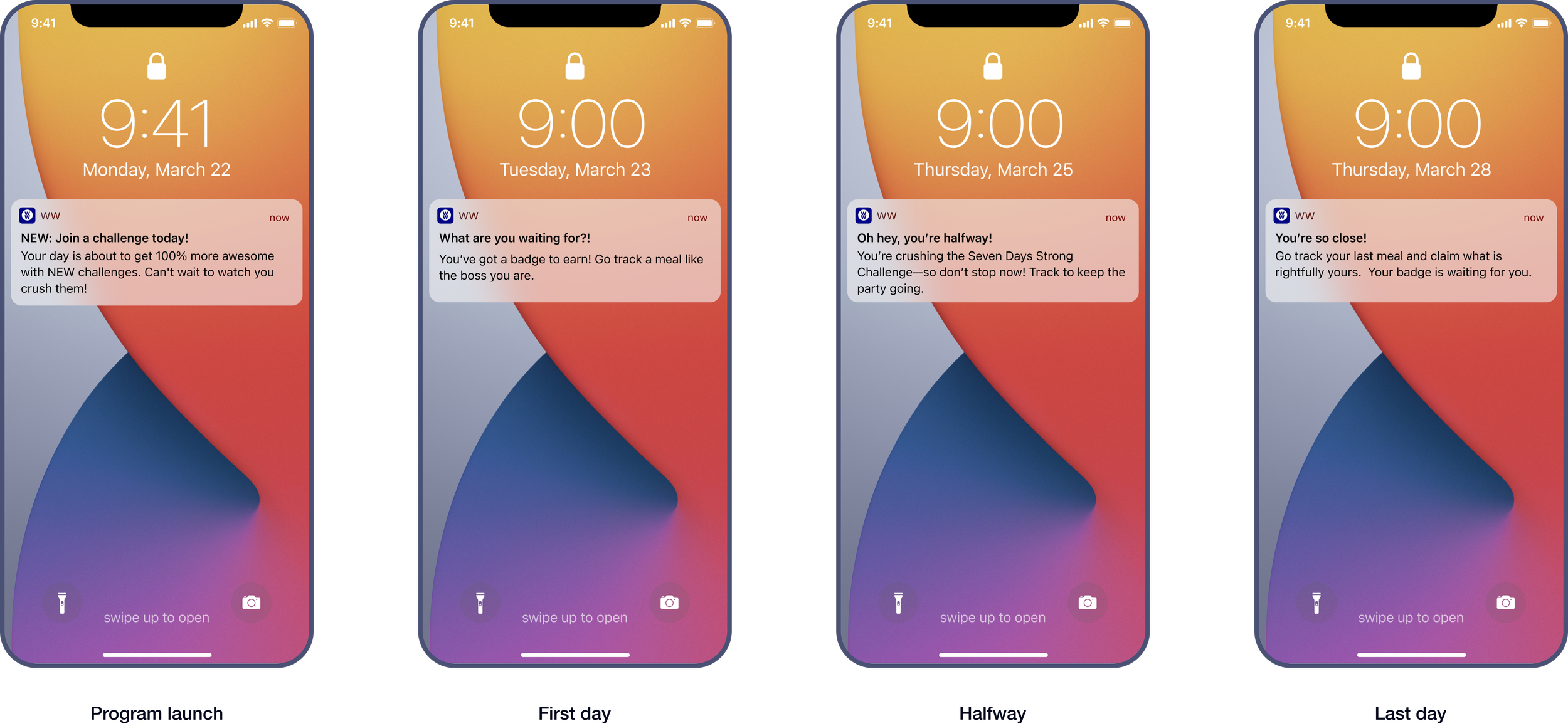Challenges & Badges
An app experience designed to motivate members and provide accountability, while creating an in-game currency not tied to real-world money. Challenges garnered over 2M sign ups in the first 8 weeks and increased tracking by over 16%.
Role: Research, UX Design, Visual Design
Year: September 2021
Client: Weight Watchers
Platform: iOS/Android

Defining The Problem
Problem #1
Members need accountability and motivation.
Members were creating their own challenges. Member created Challenges were popular on Connect (WW’s in-app social media platform), as well as on other social and in-person in Studios. This signaled there was an opportunity to fill this unmet need within the WW app.
Problem #2
The current badging system was unreliable and hard to find.
Members received badges inconsistently and didn’t feel recognized for their efforts. The old badging system was hard to find, buried under 4 clicks in the WW app. If a member rejoined the program after time off, their progress would be lost.
Problem #3
The existing rewards program was costing WW 8.2MM/year.
The business was eager to explore non-monetary ways to reward and celebrate members. WellnessWins is an expensive rewards program, costing WW millions of dollars per year. However there were still many negative reviews about the redeemable rewards.

How might we
Provide members with an extra layer of accountability and motivation that enables them to overcome the toughest hurdles they encounter along their journey?
Ideation
Brainstorming
In order to determine how to best help members overcome hurdles that prevent them from achieving success on WW, we first mapped out desired behaviors within the WellnessWins user journey. Then we tied each behavior to potential obstacles, in order to see where we could have the most impact in helping members overcome roadblocks.
We partenered with:
Design
Data Science
Project Management
Behavioral Science
Loyalty Program Manager
Identifying common barriers
Because we partnered closely with behavioral science, they helped us identify some common barriers along our customer journey such as:
Decision paralysis
The What the hell effect
Falling of the bandwagon
Future is far away
Friction
Envisioning a gamification ecosystem
We started to envision a gamification ecosystem, piecing together how all of the existing and future mechanics would work together cohesively to create a system of challenges, celebrations and rewards.
Next to each gamification mechanic are the core behavior motivators they tap into.
Creating low-fidelity sketches
We knew we had to begin building challenges so we quickly started sketching out how the experience could work.
Concept Testing
Leadership wanted to build challenges for a long time. Members had been creating their own in-app, in studios as well as on social media so we were certain there was an unmet need that could be solved directly in the app.
Ideally, leadership would come to design with problems to be solved, not solutions to be vetted. Though this was not an ideal design process, we used member-centric design thinking and user research in order to build the best solution possible. Since building the back-end achievements architecture to support this endeavor would require a large LOE, we needed to test and validate the concept with data.
Test userflow
Early wireframes
A/B Testing Challenges
To determine which types of Challenges to pursue, we A/B tested 5 different challenges based on behaviors core to success on the program.
Technical Constraints
Automatic opt-in
Members could not opt in or out, meaning the challenge would continue to appear in their app whether they wanted to participate or not.
Short window to track
Members were given a 24h window to track for the Challenge each day. If they missed it, they were immediately disqualified.
Randomly assigned
Members were randomly assigned a challenge and could not choose the one that worked best for them.

A/B Test Results
Due to tight time constraints and pressure from leadership to test Challenges ASAP, we released a lower-effort A/B test. Tests ran with Digital members from the U.S. market for a duration of 4 weeks each.
9.3%
Increase in weekend tracking
12%
Decrease in cancellations
16.3%
Increase in weekend tracking
XR Testing Challenges
It’s not typical that an AB test is released before XR testing, but in this case due to constraints we built a paired down experience and learned quickly.
However, we were very curious as to why certain challenges performed better than others, so we followed up with participants who were both in our AB test and not in the original AB test, to see what more we could learn. The AB test was great for preliminary high-level learnings about which Challenges members gravitated toward, but there were still a lot of questions left unanswered.
Key Insights
Challenges fill an unmet need for interactivity and accountability for digital-only members.
Members expect and desire difficult challenges. Ppts did not find the Weekend or 75 Wins challenges to be difficult enough.
Challenges could solve for boredom as a result of weight loss plateaus, and jump-start habit formation.
Challenges remind members to open the WW app, and anything that helps members remember to open WW is helpful.
Choice is more engaging than being assigned a challenge because it creates a personal investment in finishing it.Length of challenge is the greatest determinant of challenge difficulty.
Refining Challenges
Determining what to build for MVP.
We collaborated closely with engineers to see what was possible for our MVP. We landed on 3 food tracking challenges which all earned digital badges as a reward. Food tracking is the key behavior that was most correlated with success on Weight Watchers, so it would be a good behavior to test with.
The Weekend Challenge (tracking all Saturday and Sunday) was already built and moved food tracking by 18% so that was one we launched with.
The Good Week Challenge - (Tracking at least 1 thing a day) as it rewards consistency to help convert Newbies to Builders.
The Perfect Week Challenge - Track ALL meals for the week. As this would help us gauge the sweet spot for level of difficulty.
Based on qualitative learnings from XR, the userflow was updated to allow members to choose if they wanted to join and challenge and when they wanted to start.
Exploring visual styles for badges
I explored a wide variety of visual styles for badges in high, medium and low fidelity. Ultimately, the high fidelity designs had the most color, personality and detail and were compelling enough to stand on their own, as well as in a library.
Launching Challenges
Final design decisions
Sticky join CTA
To encourage members to join, the “start” CTA’s are sticky so that they are always above the fold.
Greater flexibility around tracking and opt-in
We convinced leadership to allow members to opt-in for this week or next as well as pre and back tracking, giving members more chances to succeed.
Push notification plan
We devised a comprehensive push notification plan to draw participants back to the app and set them up for success.

3 food-related Challenges
In order to test Challenge difficulty across a single behavior-type and learn the sweet spot for length and repetition, we tested three food related Challenges. Food tracking is the most common in-app behavior and would give us a good amount of data to learn from.
Badge designs
Aligning with Coach Lives
While we were building Challenges, another team was working on a feature called Coach Lives. I saw an opportunity to align the two experiences from a foundational component level. I worked closely with the other team’s Designer to align the experiences as closely as possible and create reusable, scalable components that were added to our Design System.

Final Screens
Push notifications
We devised a comprehensive push notification plan to draw participants back to the app and set them up for success. One at program launch, one on the first day of a selected challenge, one half way through the challenge and one on the last day of the challenge.
Updated share flow
Because we heard from members in testing it was important to be able to share their Challenges and badges, we made them shareable to Connect which was Weight Watcher In app social media platform for the MVP. The old achievement posting flow for weight loss milestones was really out dated. You needed to be able to share an image in order to share a badge. These changes enabled connect post background color options across the app experience.

Results
When we launched the test to all members we had 1.5 million Challenge opt-ins in the first 7 weeks.
1.5MM
Challenge opt-ins in the first seven weeks
12%
Successfully completed a challenge
22%
Went on to complete additional challenges
Key Learnings
You can’t redo a first impression 👀
Tabling for later can be your best bet 🗓
You can get creative while engineering has their hands full 🚀
Next Steps
Our next priority was to test non-food related challenges to see if challenges could scale beyond the most basic in-app behaviors.
Other fast follows:
Add cumulative badges to the library for core program behaviors which have been proven to lead to success like food, activity and weight tracking
Allow members to share challenges completed and badges earned outside of the app
Mystery badges
Test group challenges




















